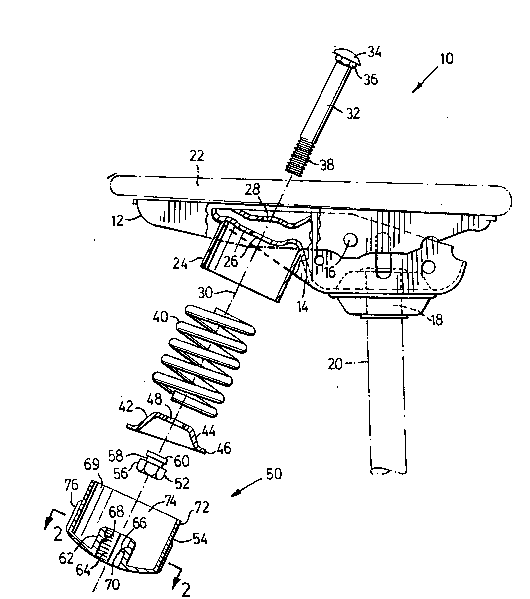Some of the information on this Web page has been provided by external sources. The Government of Canada is not responsible for the accuracy, reliability or currency of the information supplied by external sources. Users wishing to rely upon this information should consult directly with the source of the information. Content provided by external sources is not subject to official languages, privacy and accessibility requirements.
Any discrepancies in the text and image of the Claims and Abstract are due to differing posting times. Text of the Claims and Abstract are posted:
| (12) Patent: | (11) CA 2019521 |
|---|---|
| (54) English Title: | HANDLE ASSEMBLY FOR CHAIR CONTROL MECHANISM |
| (54) French Title: | LEVIER PERMETTANT LE REGLAGE DE LA CHAISE |
| Status: | Expired and beyond the Period of Reversal |
| (51) International Patent Classification (IPC): |
|
|---|---|
| (72) Inventors : |
|
| (73) Owners : |
|
| (71) Applicants : |
|
| (74) Agent: | SMART & BIGGAR LP |
| (74) Associate agent: | |
| (45) Issued: | 1994-11-15 |
| (22) Filed Date: | 1990-06-21 |
| (41) Open to Public Inspection: | 1991-12-21 |
| Examination requested: | 1992-11-20 |
| Availability of licence: | N/A |
| Dedicated to the Public: | N/A |
| (25) Language of filing: | English |
| Patent Cooperation Treaty (PCT): | No |
|---|
| (30) Application Priority Data: | None |
|---|
A chair control mechanism of the type having a seat
support member pivotally mounted on a leg mounting member, and a
spring loaded adjustment mechanism for controlling the pivotal
movement of one member with respect to the other. The adjustment
mechanism includes a handle mounted on an adjustment screw for
movement therealong to compress or allow extension of the
compression spring. A nut is threadedly mounted on the
adjustment screw and serves to retain the members, adjustment
screw and spring in an assembled configuration during shipping to
and assembly of a chair by a chair manufacturer. A hand wheel is
provided for attachment to the nut after the control mechanism
has been assembled and installed in a chair. The hand wheel has
a body of plastics material in which a seat formed which is
proportioned to accommodate and adapted to cooperate with the nut
such that when the nut is seated therein, rotation of the hand
wheel will cause rotation of the nut with respect to the
adjustment screw. The seat also cooperates with the nut to
prevent removal of the nut therefrom. The body of plastics
material is sufficiently flexible to permit resilient deformation
of the seat to admit the nut thereto.
Note: Claims are shown in the official language in which they were submitted.
Note: Descriptions are shown in the official language in which they were submitted.

2024-08-01:As part of the Next Generation Patents (NGP) transition, the Canadian Patents Database (CPD) now contains a more detailed Event History, which replicates the Event Log of our new back-office solution.
Please note that "Inactive:" events refers to events no longer in use in our new back-office solution.
For a clearer understanding of the status of the application/patent presented on this page, the site Disclaimer , as well as the definitions for Patent , Event History , Maintenance Fee and Payment History should be consulted.
| Description | Date |
|---|---|
| Inactive: IPC deactivated | 2019-01-19 |
| Inactive: IPC from PCS | 2018-01-27 |
| Inactive: IPC expired | 2018-01-01 |
| Letter Sent | 2008-01-10 |
| Letter Sent | 2007-10-29 |
| Inactive: IPC from MCD | 2006-03-11 |
| Inactive: IPC from MCD | 2006-03-11 |
| Letter Sent | 2005-10-13 |
| Time Limit for Reversal Expired | 2003-06-23 |
| Letter Sent | 2002-06-21 |
| Letter Sent | 2002-05-01 |
| Inactive: Adhoc Request Documented | 2002-04-30 |
| Inactive: Correspondence - Transfer | 2002-04-11 |
| Letter Sent | 2002-03-12 |
| Inactive: Office letter | 2002-03-12 |
| Inactive: Office letter | 2002-03-12 |
| Letter Sent | 2002-03-12 |
| Inactive: Multiple transfers | 2002-01-30 |
| Grant by Issuance | 1994-11-15 |
| All Requirements for Examination Determined Compliant | 1992-11-20 |
| Request for Examination Requirements Determined Compliant | 1992-11-20 |
| Application Published (Open to Public Inspection) | 1991-12-21 |
There is no abandonment history.
| Fee Type | Anniversary Year | Due Date | Paid Date |
|---|---|---|---|
| MF (patent, 8th anniv.) - standard | 1998-06-22 | 1998-05-19 | |
| MF (patent, 9th anniv.) - standard | 1999-06-21 | 1999-05-18 | |
| MF (patent, 10th anniv.) - standard | 2000-06-21 | 2000-06-02 | |
| MF (patent, 11th anniv.) - standard | 2001-06-21 | 2001-06-04 | |
| Registration of a document | 2002-01-30 |
Note: Records showing the ownership history in alphabetical order.
| Current Owners on Record |
|---|
| LEGGETT & PLATT LTD. |
| Past Owners on Record |
|---|
| WILLIAM S. STUMPF |